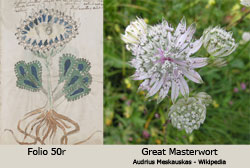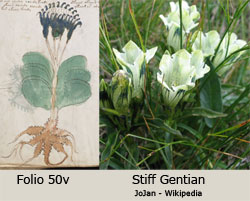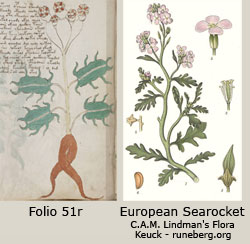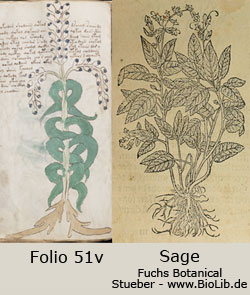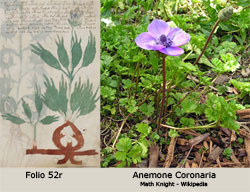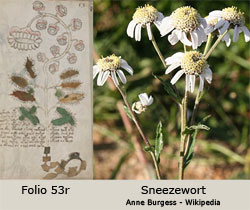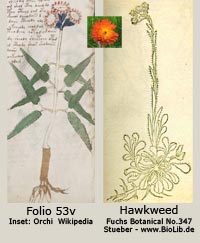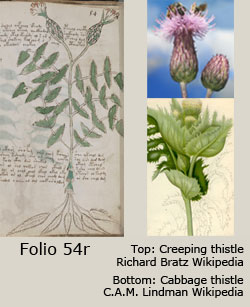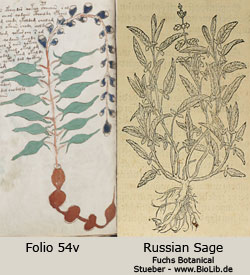The Voynich Botanical Plants
Folio 50r, Masterwort (Astrantia major), is a native of the Eastern Mediterranean and West Asia. The shiny, dark-green, palmately-lobed, and coarsely-toothed leaves are arranged in a rosette at the base of the plant. The flowers are white, pinkish, or greenish and clustered in simple umbels, which are surrounded by a conspicuous white or reddish whorl of petal-like bracts. The root is a black, woody rhizome. (Probert Encyclopedia) According to the 17th century English physician and herbalist, Culpepper, the root is hotter than pepper, and useful for treating colds and diseases of the stomach and body.
Folio 50v, Stiff Gentain (Gentiana frigida), is a member of the gentain family of plants that originated in the temperate regions of Europe and Asia. Gentians have opposite leaves that are sometimes arranged in a basal rosette, and trumpet-shaped flowers that are usually deep blue or azure, but may vary from white, cream-colored, and yellow to red. The picture of the white gentian was the only public domain photograph available. Gentian was mentioned in the works of the first century Roman physicians Pliny and Dioscorides. During the Middle Ages, Gentian was commonly employed as an antidote to poison. The long, thick root is a rhizome and has been used for centuries in Europe as a digestive aid.
Folio 51r, European Searocket (Cakile maritima), is widespread in Europe, especially on coastlines where it grows in clumps on the sand dunes. It has a taproot and its shiny, fleshy leaves are spear-shaped and deeply lobed. The white to light purple flowers grow in simple clusters at the top of erect stems. If the leaves are to be used for a salad, the plant should not be allowed to flower, but flowering plants are used for medical purposes such as treating swolen lymph nodes.
Folio 51v, Sage (Salvia officinalis), is a small, evergreen shrub native to the Mediterranean region. The long, oblong, greyish leaves are set in pairs along the woody stem. In the hot sun they tend to droop. The blue to purple flowers are in whorls at the end of the stem. All parts of the plant are strongly scented and have an astringent taste. This herb is commonly used as a seasoning. It has been recommended as a treatment for virtually every ailment and is currently used for the management of mild to moderate Alzheimer’s disease. (Akhondzadeh S, Noroozian M, Mohammadi M, Ohadinia S, Jamshidi AH, Khani M. (2003). “Salvia officinalis extract in the treatment of patients with mild to moderate Alzheimer’s disease: a double blind, randomized and placebo-controlled trial”. J Clin Pharm Ther 28 (1): 53-9.)
Folio 52r, Poppy Anemone (Anemone coronaria), is is native to the Mediteranean. This tuberous-rooted plant with deeply cut leaves has large, showy, white, red, or blue poppy-like blossoms with an involucre of three leaflets below each flower. The plant propogates from underground rootstock. It has been grown for centuries by the Greeks and Romans and was named Anemone, as was the daughter of winds in Greek mythology.
Folio 52v, Fern. The photograph shows Polystichum setiferum unfolding a frond. As none of the fronds have unfolded in Folio 52v, it is not possible to identify this fern.
Folio 53r, Sneezewort (Achillea Ptarmica), is a European herbaceous plant with a strong, pungent smell, related to yarrow. It forms dense spreading mats from rhizomes that creep beneath the ground surface. The leaves are long, grey-green, sharply toothed, and when dried are used to make a sneezing powder. It has loose heads of button-shaped, white flowers. The genus was named after Achilles, and according to the Iliad, his soldiers used this plant to treat wounds.
Folio 53v, Hawkweed (Hieracium aurantiacum), is found all over the world. It resembles a dandelion with a cluster of yellow or orange ray flowers growing at the end of a long fuzzy stalk. The leaves are lance-shaped and bristly. Pliny the Elder claimed that hawks ate the plant to improve their vision, therefore it was used as a herb to help vision problems.
Folio 54r, Cabbage thistle (Cirsium oleraceum), is native to Central Europe where it grows in boggy areas. It is an herbaceous perennial plant; the leaves are broad and ovoid with a weak, spiny margin; and the flower head is a dense cluster of sessile flowers sometimes tinged pink. The young leaves are cooked and used as a vegetable.
Folio 54v, Russian Sage (Perovskia atriplicifolia), is a small upright Asian shrub of the mint family. It has grayish white stems and deeply notched, lobed, silvery-grey leaves that smell like sage when crushed. In the late summer it produces spikes of small lavender flowers. The plant grows in clumps with new spouts coming up from the roots. It is a favorite of the honey bee.
